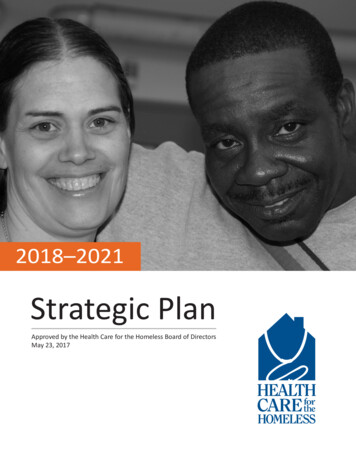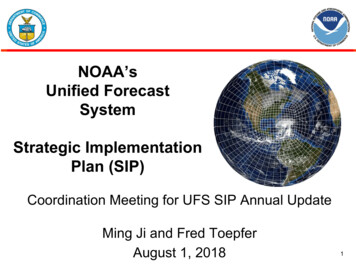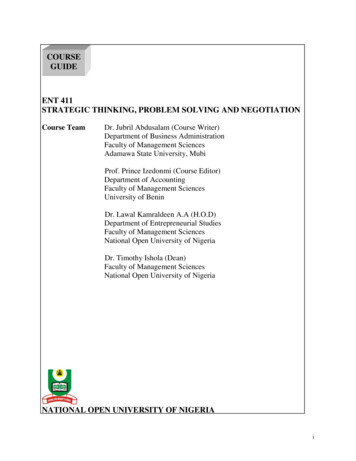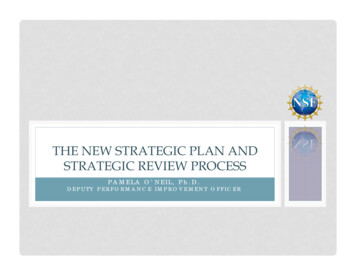
Transcription
2018–2021Strategic PlanApproved by the Health Care for the Homeless Board of DirectorsMay 23, 2017
ContentsOur Approach.3Staff Participation.4Client Participation.4Community-wide Participation.5Strategic Planning Committee.6Strategic Planning Consultant.6The 2018-2021 Strategic Plan.7Our Mandate.7Our Definition of Health Care.7The Time is Now.92018–2021 Goals.10Top Five Strengths, Weaknesses, Opportunities and Threats.112018–2021 Themes.12Appendix I: Key Steps and Timeline.14Appendix II: Staff Perspectives: Living Our Core Values.15Appendix III: Feedback from Community Conversation.17Appendix IV: Summary of Survey Results.20
3Our ApproachIn January 2017, Health Care for the Homeless engaged in a five-month strategic planning process to develop aplan to shape the agency’s direction over the next four years: 2018–2021. The process was guided by threeprinciples: our mission, our community and our core values.1. Our MissionDuring our last strategic planning process in 2012, we as a community recrafted the agency mission statement.During this latest strategic planning process in 2017, agency leadership—the Board of Directors and seniorleadership team—determined that the stated mission remains a powerful driver of the agency’s work andagreed not change it.Health Care for the Homeless works to prevent and end homelessness for vulnerable individuals andfamilies by providing quality, integrated health care and promoting access to affordable housingand sustainable incomes through direct service, advocacy and community engagement.2. Our CommunityAgency leadership chooses to define the Health Care for the Homeless community broadly and inclusively. Webelieve that real change happens when we bring people together, listen to one another and unite to act onshared goals and values. Putting our approach into practice, we designed a strategic planning process thatreflected our community and included: Staff members Board members Clients Volunteers Foundations and institutional funders Fellow service providers Social justice organizations Government agencies Landlords and property managers Philanthropists Community activists andresidents3. Our Core ValuesOur six core values are the collective promise we make each day to ourselves, to each other and to the peoplewe serve. They guide our work and relationships. They hold fast when we shift direction or change. Theyundergird our culture. And they ground us in what is good, right and true.Dignity: Fostering respect and compassionAuthenticity: Practicing open and honest communicationHope: Finding and focusing on people’s strengthsJustice: Building a healthy community that includes everyonePassion: Challenging ourselves and the world around usBalance: Caring for ourselves and helping others do the same“I appreciate being the placewhere you can come whenother places turn you away oryou feel they may not want you.Not only will we want you, butwe'll try our absolute best tohelp.”—staff member
4With assistance from our strategic planning consultant, Dr. Robert Sheehan, Jr., we collectively envisioned aworld where our mission was complete. We considered our current state, as an agency and as a country. Thenwe designed an ambitious, aspirational plan to propel us forward into that more perfect future state. Theresult is a strategic plan that: is grounded in the needs of the community and in an assessment of the currentpolitical and social environment boldly advances our mission and core values envisions the agency’s role in the local, state and national landscapes creates a shared understanding of our work articulates aspirational goals and themes for achieving these goalsStaff ParticipationHealth Care for the Homeless staff members engaged in strategic planning in a variety of ways—in smallgroups and as individuals, anonymously and publicly. 50% of our workforce (128 staff members) completed an online, anonymous survey 32 staff members self-nominated during an election for four non-management seats on thestrategic planning committee Elected staff representatives gathered input from their colleagues through:a series of lunch-hour conversations at various sitesone-on-one conversationsan in-service training for all staffbreak-out group discussions during an all-staff meetingAdditionally, they advised the Chief Strategy Officer throughout the planning process Two management team meetings were dedicated to briefing and engaging agency directors Leaders on the agency’s strategy team helped design and support implementation of the strategicplanning process (Directors of Community Relations, Development, Government Relations and HumanResources; Vice President of Communications; Chief Strategy Officer) All members of senior leadership—the Executive Team and the agency’s three vice presidents—served on the strategic planning committeeClient ParticipationThe Consumer Relations Committee (CRC) of the Board of Directors elected two client representatives torepresent client perspective and voice on the strategic planning committee. The CRC led efforts to engageclients throughout the strategic planning process. CRC members partnered with staff to administer writtensurveys across all clinic sites, including the mobile clinic, garnering 85 completed surveys. The CRC alsofacilitated strategic planning discussions during several client group meetings.
5Community-wide ParticipationMore than 55 foundations, fellow service providers, social justice organizations, government agenciesand landlords participated in the strategic planning process through a community survey, one-on-oneconversations with leaders of the agency’s strategy team and strategic planning committee or byattending a community forum on housing. These entities included:Abell FoundationAmmerman Family FoundationAnnie E. Casey FoundationB’more Housing for AllBaltimore City CouncilBaltimore City Health DepartmentBaltimore City Mayor’s OfficeBaltimore City Public SchoolsBaltimore Medical SystemBaltimore’s PromiseBehavioral Health Systems BaltimoreBon Secours Health System BaltimoreBaltimoreans United in LeadershipDevelopmentCareFirst BlueCross BlueShieldCatholic Charities of BaltimoreCenters for Medicare & MedicaidCharis Contractors, LLCConstellation-An Exelon CompanyDayspring ProgramsDisability Rights MarylandGovans Ecumenical Development CorporationThe Harry and Jeanette Weinberg FoundationHeritage Crossing AssociationHomeless Persons Representation Project, Inc.Hope Home SolutionsHouse of Ruth MarylandJacob and Hilda Blaustein FoundationJohns Hopkins MedicineJohns Hopkins Bloomberg School of PublicHealthJohns Hopkins UniversityLifeBridge HealthLoyola University MarylandMaryland Department of HealthMaryland Department of Human ResourcesMaryland Department of Veteran AffairsMaryland General AssemblyMcDaniel CollegeMercy Health ServicesMidtown Community Benefits DistrictMosaic Community ServicesOld Goucher Community AssociationPark Heights RenaissanceProject PLASE, Inc.Public Justice CenterSt. Vincent De Paul of BaltimoreThe Team Edge Properties, LLCTotal Health CareUniversity of Maryland, BaltimoreUniversity of Maryland Medical SystemUniversity of Maryland School of NursingUniversity of Maryland School of Social WorkUltimate Homes RealtyUpton Planning Committee, Inc.
6Strategic Planning CommitteeThe committee comprised 24 members, spanning the Board of Directors, senior staff, non-management staff,clients and community partners. The committee met on four occasions over four weeks for a total of 20 hours.Thomas Lansdale, MD, Chair, Board of Directors (Physician, Seasons Hospice and Palliative Care)Dennis Pullin, FACHE, Committee Chair, 2nd Vice Chair, Board of Directors (President, MedStar Harbor Hospital& Senior Vice President of MedStar Health)Kevin Lindamood, MSW, President and CEOSister Helen Amos, RSM, Executive Chair, Board of Trustees, Mercy Health ServicesJan Caughlan, MSW, LCSW-C, Vice President of Behavioral HealthLeonard Croft, Client Access Associate, Elected Staff RepresentativeTonii Gedin, DNP, RN, Chief Quality OfficerJeff Garrett, Community Advocate, ClientWanda Gibson Best, Executive Director, Upton Planning CommitteeAthena Haniotis, Community Advocate, ClientKeiren Havens, Chief Strategy OfficerDan Hendricks, Lead Benefits Specialist, Elected Staff RepresentativeNilesh Kalyanaraman, MD, FACP, Chief Health OfficerChelsea King, Member, Board of Directors (Senior Manager, Product Innovation, Inovalon, Inc.)Elena Marcuss, Esq., Secretary, Board of Directors (Partner, McGuireWoods, LLP)Maria Martins-Evora, MSW, Chief Administrative OfficerCheryl Matricciani, CPA, Esq., 1st Vice Chair, Board of Directors (Vice President & General Counsel, MedicalMutual Liability Insurance Company of Maryland)Dan McCarthy, Member, Board of Directors (Executive Director, Episcopal Housing Corporation)Molly Rath, Vice President of CommunicationsBilqis Rock, LCSW-C, SOAR Coordinator, Elected Staff RepresentativePhill Sheldon, LCSW-C, Convalescent Care Coordinator, Elected Staff RepresentativeAdrienne Trustman, MD, Vice President of MedicineGeorge Watson, Treasurer, Board of Directors (Consultant, BW Partners LLC)Thomas Welliver, Chief Financial OfficerSpecial appreciation to Von Bradshaw, Executive Assistant, for her logistical support of the committee.Strategic Planning ConsultantDr. Robert M. Sheehan, Jr. has more than 30 years of executive management experience, including 18 years asthe CEO of two different national nonprofits. In addition to running Sheehan Nonprofit Consulting, Dr. Sheehanis the Academic Director of the Executive MBA program at the Robert H. Smith School of Business at theUniversity of Maryland, College Park. He was the strategic planning consultant who facilitated our strategicplanning process in 2012 and we were very glad to partner with him once again in 2017.
The 2018-2021 Strategic Plan7Our MandateHomelessness in America is unacceptable. This remains as true today as it was in 1985 when Health Care forthe Homeless was founded. Since that time, deliberate public policy decisions continue to decrease access toaffordable housing, widen the divide between rich and poor and weaken the social safety net—resulting inmore families on the streets. The consequences are devastating and life-threatening for individuals, familiesand communities. Our agency exists to close the gap between this shameful reality and a just society.As of 2016, at least 1.5 million Americans experienced homelessness and an additional 20 million were“housing burdened”—at risk of homelessness by paying more than 30% of their income for rent. Furthercuts to federal safety net programs remain a real possibility over the next four years, pushing overwhelmingfunding responsibilities to overburdened states and cities. Congress is considering additional reductions tothe federal Department of Housing and Urban Development, which would scale back an already insufficientsupply of subsidized affordable housing. Following historic gains in access to health care for low-incomepeople, both Medicaid and Medicare are under review by the current administration—threatening toreverse demonstrated progress of the past four years. Concurrent to this threat, the future of Maryland’sunique “all payer” hospital waiver—a critical component of our regional health care system – faces anuncertain future.Emboldened by collective experience of the past 32 years, we embrace the urgency of our founders, even ascurrent social and political realities threaten to undermine our progress. Rooted in the struggles andsuccesses of the people we serve, we have learned much about homelessness and how to end it. Over thenext four years, we will boldly champion the strategies we know to be effective in improving health andending homelessness.Our Definition of Health CareFrom the beginning, Health Care for the Homeless has understood contemporary homelessness as asymptom of poverty, the lack of affordable housing and restricted access to health care. Cuts to the federalDepartment of Housing and Urban Development between 1979 and 1989 fueled a reemergence ofhomelessness not seen since the Great Depression. This surge gave rise to a patchwork of public and privateemergency interventions such as emergency shelter, transitional housing and the Health Care for theHomeless program. The same people who needed housing also needed access to health insurance andspecialty care. The result? If people experienced homelessness, chances were great they also were sick.Life on the street is brutal. People experiencing homelessness are three to four times more likely to dieprematurely and twice as likely to have a heart attack or stroke than people who have housing. The lack ofshelter, food, income, hygiene and health care makes it nearly impossible to be healthy. Their life expectancyis just 48 years. This population’s circumstances required going far “above and beyond” traditional models ofcare. In fact, it required redefining health care.
8Whole-Person, Team-Based CareOver the past three decades, we have developed a multidisciplinary model of health care with the ultimategoal of ending our clients’ homelessness. Delivering this demanding degree of care requires providers fromacross medical, dental and behavioral health professions. They must collaborate closely with one anotherin order to best serve clients living in very traumatic circumstances.In 2016, we introduced multidisciplinary, integrated care teams—teams whose members focus theircollective attention on their clients’ progress toward key outcomes. Each team shares a panel of clients,collaborating to develop goals and a care plan with each client. We modeled our care teams after patientcentered medical homes, an evidence-based practice that is taking hold across the health care industry.Together, medical and behavioral health staff track and monitor high-risk conditions among our clients, andinstitute care practices known to reduce the risk and manage the care of chronic illnesses. Now, with morelocations, disciplines, clients and staff than ever before, we rely heavily on data and metrics to refine ourpractices. While we have basic roadmaps from the health care industry, we are charting our ownpath—and testing and refining it along the way, tailoring it to meet the specific needs of our clientpopulation. We are committed to sharing our practices and our data, as well as our successes and ourfailures, in order to improve the health care delivery systems for vulnerable populations across the country.Housing is Health CareFrom our earliest days, we argued that individuals had to be housed in order to get healthy. Meanwhile,public policy dictated that people with significant medical and behavioral health problems were not“housing ready.” As a result, many sick individuals stayed on the streets and suffered significant healthconsequences. Frustrated by this reality, we worked with our clients individually to apply for governmentaldisability assistance to secure modest room rentals. Our newly housed clients’ improved health andstability supported our assertion: Housing is health care.In recent years, “housing first” has gained traction. Housing first proponents posited that people should beplaced in housing right away—without the precondition of treatment—and given intensive supportiveservices to remain stably housed. Health research from across the country backed up this approach, whilealso revealing significant reductions in emergency room usage, hospitalization and public safety costs.We at Health Care for the Homeless made our own forceful case for housing first in 2005, as part of apartnership with Baltimore City to place 30 people living in a downtown park in scattered-site privateapartments and providing intensive social services. When all the participants remained housed a year later,the federal Substance Abuse and Mental Health Services Administration and Baltimore City funded theexpansion of the model. Since then, we have helped more individuals and families get housed and stayhoused—100 people alone in 2016.
9The Power of Housing Health CareHealth Care for the Homeless has created a powerful and unique combination of whole-person,team-based care with supportive housing services. Case managers and outreach workers refer clientsfor housing through the Baltimore City Coordinated Access System. Benefits specialists help clientssecure income to defray housing costs. Teams of clinicians and peer advocates help clients locate andmove into housing, coordinate medications, provide transportation to appointments and groceryshopping, assist with paying bills and manage relationships with landlords. Development teammembers raise funds for move-in kits for newly housed clients. All 240 staff members advocate forpolicies that increase access to affordable housing.But the fundamental problem remains: There isn’t enough affordable housing.The Time is NowUrgency, coupled with the passion and commitment of our community, spurred the strategic planningcommittee to create aggressive, “near-impossible” goals to address the gap between the way things arenow and the way things should be. Everyone deserves to have a home, and so we commit the next fouryears to developing housing and supportive services to get—and keep our clients housed.Across the community, the call for Health Care for the Homeless to create affordable housing stock isloud and pervasive. We hear it from our elected officials, our fellow advocates and, most importantly,from our fellow community members. This commitment to housing development brings us full-circle:Disinvestment in affordable housing created contemporary homelessness. Only reinvestment inhousing and comprehensive supportive services can end it. The mandate is clear: The time is now.“Homelessness makes yousick. Being very sick can makeyou homeless. If you are sick,homelessness can make yousicker.”—Kevin LindamoodPresident & CEO
102018–2021 GoalsOur mission to prevent and end homelessness compels us to think boldly and creatively. Our communitydemands that we act with urgency because the current reality is unacceptable. Our goals areaspirational by design and we embrace them fully, knowing that we may fall short. Our commitment toour core values allows for nothing less.1. 100% of the people we serve will have timely access to quality, whole-personhealth care and affordable housing.We envision a community where:1.1. Clients get the care and housing they need, when they need it1.2. We continually strive to improve the services and care we deliver1.3. Staff members are prepared and supported to do their very best work2. We will design and implement sustainable business models for affordable housingdevelopment and supportive housing.We envision a community where:2.1. We, through public and private partnerships, create new affordable housing units2.2. There is broad commitment and support for affordable housing2.3. Clients have homes and the support they need to participate in their communities3. As a result of our care, the health outcomes of our clients will rival the healthoutcomes of a stable population.We envision a community where:3.1. We improve the health of all clients, despite their health and housing instability3.2. Our model of care is proven to work for highly vulnerable populations3.3. Clients can manage their own care to the best of their ability
11Top Five Strengths, Weaknesses, Opportunities and ThreatsBy identifying our strengths, weaknesses, opportunities and threats (SWOTs), the strategic planningcommittee began to understand how to move the agency forward. As our strategic planning consultant RobSheehan advised, we would use SWOTs to create themes that would leverage our strengths, fortify ourweaknesses, seize opportunities and block threats.StrengthsS1. Passionate, driven staff who care deeply about the people they serve, their community and social justiceS2. A diverse and mission-driven community that spans individuals, grassroots organizations, fellow serviceproviders, funders and corporationsS3. The agency’s reputation in the community as a quality provider and advocacy partner with clientsS4. Financial stability that has been achieved over the past five years, as exemplified by a strong cashposition, a newly-launched endowment and an investment portfolioS5. A portfolio of health care services that includes and integrates supportive housingWeaknessesW1. Management has insufficient change management in place, so staff are not adequately prepared,equipped or supported to drive agency success and outcomesW2. Lack of a shared definition of our client population across all teams, which limits client access, makesaccess inconsistent and leads to confusion among both staff and clientsW3. Underdeveloped infrastructure and communications appropriate for a business of our size andcomplexity leaves staff feeling unsupported and unclear about policies, procedures and practicesW4. Limited staff resources and capacity to lead ambitious initiatives, support research or participate inadvocacy effortsW5. No staff knowledge or expertise in housing development and property managementOpportunitiesO1. Across the health care industry, there is broad interest in population health management, particularlyfor individuals with complex, chronic conditions or diseasesO2. Since our inception, we have relied on partnerships and have a strong network to build uponO3. Because of the agency’s reputation and mission, we are well-positioned to leadO4. Research opportunities abound in the Baltimore area, due to the number of universities and researchinstitutionsO5. Our current locations are growing and expanding to meet client demand for our servicesThreatsT1. Financing for our work is highly dependent upon governmental funding sourcesT2. The political landscape is bleak, with a lack of support for basic social services or housingT3. Baltimore suffers from competing local priorities that are important and pressing as the federalgovernment threatens to withdraw support for cities and states, and in turn, tighten their beltsT4. Misconceptions about the population we serve are surging—harmful stereotypes threaten people whodeserve resources and support to be healthy and stable members of societyT5. Organizational burnout threatens staff in health care and in the non-profit world, where work ispsychologically demanding and work-life balance can be hard to maintain
122018–2021 ThemesThemes are the descriptions of how we will achieve our goals. They will guide our annualoperational plans and the measures through which we will hold ourselves accountable.1. Build a strong agency infrastructure to recruit, retain, support and communicatewith staffWe will hold ourselves accountable for:1.1 Establishing and sharing annual objectives that guide agency activities1.2 Clarifying and communicating decision-making processes and decisions1.3 Ensuring that staff receive the support they need to adapt, grow and lead successfully1.4 Creating a robust training and development program1.5 Designing staffing patterns and metrics that support both client health and staff wellness2. Strengthen client participation and promote client leadership to keep us true toour shared mission and valuesWe will hold ourselves accountable for:2.1 Adhering to a shared definition of our client population across all teams2.2 Improving the self-management ability of clients2.3 Systematically incorporating client perspective into work and decision-making, especiallyaround quality improvement and population health2.4 Increasing opportunities for client participation, client leadership, self-advocacy andfeedback2.5 Standardizing client transitions—from one provider to another, either within ourpractice or to a provider in the broader community3. Launch ambitious advocacy and capital campaigns to secure the resources andsupport we need to achieve our goalsWe will hold ourselves accountable for:3.1 Creating a bold vision that will inspire the community to act on behalf of our mission andclients3.2 Growing the number of donors, the size of their gifts and the total amount of fundingfrom the community3.3 Crafting an influential leadership role in advocacy and policy to support clients’ access tohousing3.4 Strengthening our network of advocates, policy experts, decision makers and supportersin the geographical areas we serve3.5 Expanding an advocacy program that leverages the strengths of staff, clients, boardmembers, donors and community partners
134. Develop the data, systems and practices to monitor, report and improve our outcomesWe will hold ourselves accountable for:4.1 Setting challenging performance goals and sharing progress and results with ourcommunity4.2 Equipping and training staff to capture and use data to inform delivery of optimal care4.3 Caring for clients in ways that prevent disease and prioritizing those with chronicconditions4.4 Ensuring that we meet standards for safe and effective care4.5 Constantly adjusting our practices to do better, particularly by incorporatingevidence-based practices5. Create new partnerships to generate innovation, research and publication in healthcare and housingWe will hold ourselves accountable for:5.1 Investing in our capacity to identify trends in our data and population5.2 Increasing agency knowledge and capacity to support housing development5.3 Establishing new partnerships that result in expanded housing for clients5.4 Collaborating with experienced partners to conduct research that supports our goals5.5 Sharing information that has the potential to improve care or access to housing forvulnerable populations“Health Care for the Homeless is the most caring spot in the city for people struggling withhousing instability. A place where such people are treated with dignity and where they canaccess essential wrap-around support and quality health care without judgement.”—Jennifer Pelton, Public Justice Center
14Appendix I: Key Steps and TimelineCommunity input came in the form of surveys, group discussions and one-on-one meetings—from anestimated 450 people. The strategic planning committee drew on this input to (a) create goals; (b) identifyagency strengths, weaknesses, threats and opportunities; and (c) delineate themes.Timeline: January–MayJan. 24Jan. 27Feb. 15Mar. 1Mar. 9Mar. 10Mar. 15Mar. 16Mar. 17Mar. 21Mar. 30Apr. 3Apr. 4Apr. 17Apr. 19Apr. 20Apr. 24Apr. 25Apr. 26Apr. 27May 4May 23Management team meeting: Introduction to strategic planningBoard of Directors meeting: Introduction to strategic planningSenior leadership team (Executive Team and vice presidents) meeting with RobSheehanLaunch of online community surveyStaff election of four staff representatives to the strategic planning committeeLaunch of staff surveyStrategy team leaders begin to hold one-on-one meetings with community leadersAll-staff meeting: Breakout group discussions on lowest-scoring core values from staffsurvey (led by elected staff representatives)Consumer Relations Committee discussionLaunch of client surveyWomen’s Group and Men’s Group: Client-led discussionsConvalescent Care Program residents’ meeting: Client-led discussionBaltimore County advocacy meeting: Client-led discussionSenior leadership team: Introduction to “Mission Metrics”B’More Housing for All, Diabetes Group, Spanish Group: Client-led discussionsAll-staff in-service: “Dream big: What is your vision for our community? How shouldthe agency make that vision a reality?” (led by elected staff representatives)First strategic planning committee meetingCommunity meal and conversation: Agency’s role in housingManagement team meeting: Presentation of surveys and resultsSecond strategic planning committee meetingStaff lunch-time discussions on draft goals with elected staff representatives(Fallsway clinic)Staff Lunch-time discussions on draft goals with elected staff representatives(West Baltimore clinic)Staff Lunch-time discussions on draft goals with elected staff representatives(201 E. Baltimore St. location)Board of Directors meeting: Discussion of draft goals with Rob SheehanManagement team meeting: Discussion of draft goalsEmail to community members eliciting feedback on draft goalsStaff discussions on draft goals with elected staff representatives (Convalescent CareProgram)Third strategic planning committee meetingFinal strategic planning committee meetingBoard of Directors meeting and approval
Appendix II: Staff Perspectives: Living Our Core ValuesAn early step in the 2017 strategic planning process was the administration of an online, anonymous staffsurvey. The survey contained a set of questions
University of Maryland School of Nursing University of Maryland School of Social Work Ultimate Homes Realty Upton Planning Committee, Inc. Abell Foundation Ammerman Family Foundation Annie E. Casey Foundation B'more Housing for All Baltimore City Council Baltimore City Health Department Baltimore City Mayor's Office Baltimore City Public .










